

If you are a tennis player, you may be more prone to experiencing certain overuse injuries of the lower extremities. “Jumper’s knee,” or patellar tendonitis, is one of these injuries. It occurs when the patellar tendon, which holds the knee straight, tears over time. Pain can be felt under the kneecap, and it may be difficult (or impossible) to straighten your leg. Achilles tendonitis is another common tennis injury. It occurs when the Achilles tendon, which connects the heel bone with the calf muscles, is chronically stressed and becomes inflamed and painful. Suddenly increasing the intensity or duration of play can sometimes cause this condition to occur. Ankle sprains are another common injury in tennis players, as the sport requires quick position changes, pivots, and sprints. This injury causes pain, swelling, tightness, and sometimes bruising in the ankle. Plantar fasciitis occurs when the plantar fascia tissue, which runs along the sole of the foot, gets overstressed, inflamed, and sometimes torn. Playing tennis can also cause a great deal of repetitive stress on bones, which ultimately may lead to a stress fracture. The shin bone is particularly prone to stress fractures which can produce a dull ache and weakness in the affected bone. If you have suffered any of these injuries or would like information on how to protect yourself from them, contact a podiatrist.
Ankle and foot injuries are common among athletes and in many sports. They can be caused by several problems and may be potentially serious. If you are feeling pain or think you were injured in a sporting event or when exercising, consult with the podiatrists from The Foot & Ankle Center of New Jersey. Our doctors will assess your condition and provide you with quality foot and ankle treatment.
Common Injuries
The most common injuries that occur in sporting activities include:
Symptoms
Symptoms vary depending upon the injury and in some cases, there may be no symptoms at all. However, in most cases, some form of symptom is experienced. Pain, aching, burning, bruising, tenderness, tightness or stiffness, sensation loss, difficulty moving, and swelling are the most common symptoms.
Treatment
Just as symptoms vary depending upon the injury, so do treatment options. A common treatment method is known as the RICE method. This method involves rest, applying ice, compression and elevating the afflicted foot or ankle. If the injury appears to be more serious, surgery might be required, such as arthroscopic or reconstructive surgery. Lastly, rehabilitation or therapy might be needed to gain full functionality in the afflicted area. Any discomfort experienced by an athlete must be evaluated by a licensed, reputable medical professional.
If you have any questions, please feel free to contact our office located in Ridgewood, NJ . We offer the newest diagnostic and treatment technologies for all your foot care needs.
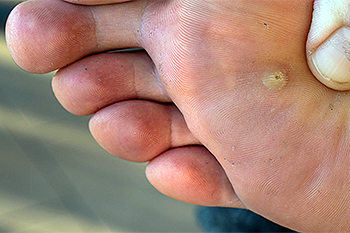
Warts are areas of hardened skin that typically have a bumpy surface. They come in various sizes, shapes, and colors and can appear anywhere on the body. Plantar warts occur on the bottom of the feet. Children get them more often than adults. Viruses from the human papillomavirus (HPV) cause warts. Kids can get warts from touching a towel or surface that someone else with a wart has used and pick up HPV. Warts thrive in warm, moist environments like the feet. Plantar warts can grow for a long time before they are visible. Walking barefoot in public places and not cleaning and drying the feet well regularly makes one more susceptible to plantar warts. These warts can cause considerable discomfort and feel like there is a rock in one’s shoe. One should not pick at, rub, or scratch a wart. Most of the time, these warts will go away on their own, but they can recur. Plantar warts can be treated with medicine containing mild acid that removes dead skin cells on the wart, cryosurgery - where the doctor uses a chemical repeatedly across a few weeks to freeze the wart and kill the virus, or other means of removing the wart. It is a good idea to take your child to a podiatrist to have the plantar wart treated and not try to remove it on your own.
Plantar warts can be very uncomfortable. If you need your feet checked, contact the podiatrists from The Foot & Ankle Center of New Jersey. Our doctors will assist you with all of your foot and ankle needs.
About Plantar Warts
Plantar warts are the result of HPV, or human papillomavirus, getting into open wounds on the feet. They are mostly found on the heels or balls of the feet.
While plantar warts are generally harmless, those experiencing excessive pain or those suffering from diabetes or a compromised immune system require immediate medical care. Plantar warts are easily diagnosed, usually through scraping off a bit of rough skin or by getting a biopsy.
Symptoms
Treatment
To help prevent developing plantar warts, avoid walking barefoot over abrasive surfaces that can cause cuts or wounds for HPV to get into. Avoiding direct contact with other warts, as well as not picking or rubbing existing warts, can help prevent the further spread of plantar warts. However, if you think you have developed plantar warts, speak to your podiatrist. He or she can diagnose the warts on your feet and recommend the appropriate treatment options.
If you have any questions please feel free to contact our office located in Ridgewood, NJ . We offer the newest diagnostic and treatment technologies for all your foot and ankle needs.
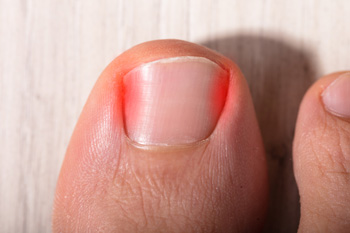
The medical term for an ingrown toenail is onychocryptosis. It is a painful foot condition that occurs when the toenail grows into the skin on the side of the nail. It can happen as a result of wearing shoes that do not fit properly. Additionally, it may happen from cutting the toenails incorrectly. The proper way to trim toenails is to cut them straight across, and not rounded. Ingrown toenails typically affect the big toe, and research has shown it is a more common condition among men rather than women. Incurring a foot injury may lead to developing an ingrown toenail. This can happen if the foot is jammed against a piece of furniture, or has become damaged from a heavy object dropping on it. Common symptoms of an ingrown toenail include redness, tenderness, and pain. It may feel better when the affected toe is soaked in warm water, which can make it easier to gently pull the skin away from the nail. It is suggested that if you have an ingrown toenail you are under the care of a podiatrist who can offer you proper treatment methods.
Ingrown toenails can become painful if they are not treated properly. For more information about ingrown toenails, contact the podiatrists of The Foot & Ankle Center of New Jersey. Our doctors can provide the care you need to keep you pain-free and on your feet.
Ingrown Toenails
Ingrown toenails occur when a toenail grows sideways into the bed of the nail, causing pain, swelling, and possibly infection.
Causes
Prevention
Because ingrown toenails are not something found outside of shoe-wearing cultures, going barefoot as often as possible will decrease the likeliness of developing ingrown toenails. Wearing proper fitting shoes and using proper cutting techniques will also help decrease your risk of developing ingrown toenails.
Treatment
Ingrown toenails are a very treatable foot condition. In minor cases, soaking the affected area in salt or antibacterial soaps will not only help with the ingrown nail itself, but also help prevent any infections from occurring. In more severe cases, surgery is an option. In either case, speaking to your podiatrist about this condition will help you get a better understanding of specific treatment options that are right for you.
If you have any questions please feel free to contact our office located in Ridgewood, NJ . We offer the newest diagnostic and treatment technologies for all your foot and ankle needs.
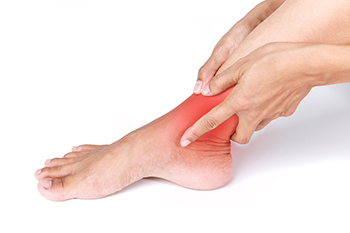
Most people do not spend a lot of time thinking about the health of their ankles, but this important joint is a workhorse for your body. When you trip but don’t fall, it’s because your ankles have kept you upright. If you need to switch directions in a hurry, it is the ankles that make it possible. One quick way to assess the health of your ankles is by taking a simple test. If you already are experiencing ankle pain, it is best to skip this test and seek out help from a podiatrist as soon as possible. Sit in a straight chair, extend your leg, and turn your ankle clockwise a few times, and then repeat counterclockwise. Try it on the other foot. No pain? That means your ankles are probably doing well. If one ankle is not responding as well as the other one, it may be an indication that something is wrong. Make a note of which part of the ankle hurts, how often the pain occurs, and what you are doing when it starts. This would be a good time to make an appointment with a podiatrist for an examination, diagnosis and possible treatment plan.
Ankle pain can be caused by a number of problems and may be potentially serious. If you have ankle pain, consult with the podiatrists from The Foot & Ankle Center of New Jersey. Our doctors will assess your condition and provide you with quality foot and ankle treatment.
Ankle pain is any condition that causes pain in the ankle. Due to the fact that the ankle consists of tendons, muscles, bones, and ligaments, ankle pain can come from a number of different conditions.
Causes
The most common causes of ankle pain include:
Symptoms
Symptoms of ankle injury vary based upon the condition. Pain may include general pain and discomfort, swelling, aching, redness, bruising, burning or stabbing sensations, and/or loss of sensation.
Diagnosis
Due to the wide variety of potential causes of ankle pain, podiatrists will utilize a number of different methods to properly diagnose ankle pain. This can include asking for personal and family medical histories and of any recent injuries. Further diagnosis may include sensation tests, a physical examination, and potentially x-rays or other imaging tests.
Treatment
Just as the range of causes varies widely, so do treatments. Some more common treatments are rest, ice packs, keeping pressure off the foot, orthotics and braces, medication for inflammation and pain, and surgery.
If you have any questions, please feel free to contact our office located in Ridgewood, NJ . We offer the newest diagnostic and treatment technologies for all your foot care needs.
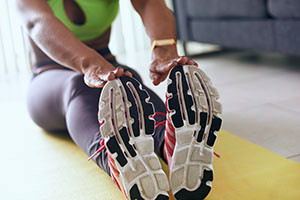
Running injuries are common among people who are athletic. It is important to practice running injury prevention techniques, and this can be accomplished in several ways. Warming up and cooling down before running is essential in keeping the body strong, and free of injury. Additionally, it is beneficial to gradually increase speed and mileage, and wearing shoes that fit correctly may help to prevent running injuries. Many runners can suffer from an acute injury, and this can happen from a fall or bumping into another runner. Such injuries can affect the ligaments and tendons, and walking can be difficult. Relief can be found when the affected foot is elevated, and this may help to reduce existing swelling. Chronic injuries are considered to be the most common type of running injury, and often includes stress fractures. It is advised that you consult with a podiatrist who can educate you about different types of running injuries, and offer methods on how they can be prevented.
Exercising your feet regularly with the proper foot wear is a great way to prevent injuries. If you have any concerns about your feet, contact the podiatrists of The Foot & Ankle Center of New Jersey. Our doctors will treat your foot and ankle needs.
How to Prevent Running Injuries
Many common running injuries are caused by overuse and overtraining. When the back of the kneecap starts wearing out and starts causing pain in your knee, this is commonly referred to as runner’s knee. Runner’s knee is a decrease in strength in your quadriceps and can occur if you’re not wearing properly fitted or supporting shoes. To prevent runner’s knee, focusing on hip strengthening is a good idea, as well as strengthening your quads to keep the kneecaps aligned.
What Are Some Causes of Running Injuries?
- One cause of a common running injury is called iliotibial band syndrome.
- Plantar fasciitis is also another common injury.
- Stress fractures can occur from overtraining, lack of calcium, or even your running style.
Best Ways to Prevent Running Injuries
- Wear footwear that fits properly and suits your running needs.
- Running shoes are the only protective gear that runners have to safeguard them from injury.
- Make a training schedule. Adding strengthening exercises as well as regular stretching can help keep you strong and limber and can lessen the possibility of injuries.
- Stretching keeps muscles limber; this will help you gain better flexibility.
If you have any questions please feel free to contact our office located in Ridgewood, NJ . We offer the newest diagnostic and treatment technologies for all your foot and ankle needs.
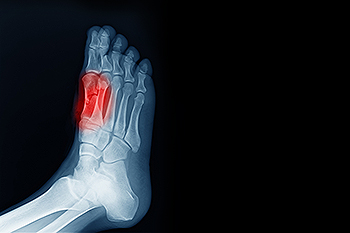
The group of bones that are under the bottom of the big toe include the sesamoid bones. They protect specific tendons in the foot, and absorb most of the weight on the inside of the foot. The condition that is known as sesamoiditis occurs when the sesamoid bones become inflamed. They can become injured as a result of enduring a stress fracture, or from an injury that comes from repetitive motion consisting of dancing. Many patients need to have a proper diagnosis performed, which includes having an X-ray taken that can rule out a fracture. Correct treatment techniques can possibly reduce painful symptoms, in addition to protecting the foot from further injury. These can consist of wearing orthotic insoles, taking anti-inflammatory medication, or possible surgery. If you feel you have injured your sesamoid bones, it is strongly urged that you confer with a podiatrist who can help you to manage this condition, in addition to offering you correct treatment solutions.
Sesamoiditis is an unpleasant foot condition characterized by pain in the balls of the feet. If you think you’re struggling with sesamoiditis, contact the podiatrists of The Foot & Ankle Center of New Jersey. Our doctors will treat your condition thoroughly and effectively.
Sesamoiditis
Sesamoiditis is a condition of the foot that affects the ball of the foot. It is more common in younger people than it is in older people. It can also occur with people who have begun a new exercise program, since their bodies are adjusting to the new physical regimen. Pain may also be caused by the inflammation of tendons surrounding the bones. It is important to seek treatment in its early stages because if you ignore the pain, this condition can lead to more serious problems such as severe irritation and bone fractures.
Causes of Sesamoiditis
Treatment for sesamoiditis is non-invasive and simple. Doctors may recommend a strict rest period where the patient forgoes most physical activity. This will help give the patient time to heal their feet through limited activity. For serious cases, it is best to speak with your doctor to determine a treatment option that will help your specific needs.
If you have any questions please feel free to contact our office located in Ridgewood, NJ . We offer the newest diagnostic and treatment technologies for all your foot and ankle needs.

When body tissue is exposed to the environment, it is known as an open wound. Proper wound care is needed if there is bleeding, or if you have developed a broken bone. A closed wound occurs when there is bleeding under the surface of the skin and is referred to as a bruise. A break in the skin that comes from a fall or surgery is an open wound and requires immediate medical attention. The first step would be to stop the bleeding, followed by cleaning the wound. If the wound is severe antibiotics may be needed, and the wound can be dressed. It is important to change the dressing routinely, and this helps check if an infection has developed. Many diabetic patients are prone to developing wounds on the feet, and proper treatment must be provided. If you have a wound on your foot, it is suggested that you consult with a podiatrist who can offer you the best remedy for wound care on the feet.
Wound care is an important part in dealing with diabetes. If you have diabetes and a foot wound or would like more information about wound care for diabetics, consult with the podiatrists from The Foot & Ankle Center of New Jersey. Our doctors will assess your condition and provide you with quality foot and ankle treatment.
What Is Wound Care?
Wound care is the practice of taking proper care of a wound. This can range from the smallest to the largest of wounds. While everyone can benefit from proper wound care, it is much more important for diabetics. Diabetics often suffer from poor blood circulation which causes wounds to heal much slower than they would in a non-diabetic.
What Is the Importance of Wound Care?
While it may not seem apparent with small ulcers on the foot, for diabetics, any size ulcer can become infected. Diabetics often also suffer from neuropathy, or nerve loss. This means they might not even feel when they have an ulcer on their foot. If the wound becomes severely infected, amputation may be necessary. Therefore, it is of the upmost importance to properly care for any and all foot wounds.
How to Care for Wounds
The best way to care for foot wounds is to prevent them. For diabetics, this means daily inspections of the feet for any signs of abnormalities or ulcers. It is also recommended to see a podiatrist several times a year for a foot inspection. If you do have an ulcer, run the wound under water to clear dirt from the wound; then apply antibiotic ointment to the wound and cover with a bandage. Bandages should be changed daily and keeping pressure off the wound is smart. It is advised to see a podiatrist, who can keep an eye on it.
If you have any questions, please feel free to contact our office located in Ridgewood, NJ . We offer the newest diagnostic and treatment technologies for all your foot care needs.
If you have heel pain and think you might have plantar fasciitis, assess your risk factors. Do you stand for prolonged periods of time or run excessively? Do you lead a sedentary lifestyle or have a body mass index (BMI) greater than 27? Do you pronate (turn your foot inward) excessively when you walk? Do you have high arches? Is it difficult for you to bend your ankle? Now, contemplate the pain you are experiencing. Does it feel worse when you first get out of bed in the morning, then get better after you start to move around, only to return towards the end of the day? If you answered yes to one or more of these questions, you are at an increased risk of developing plantar fasciitis and are exhibiting its typical symptoms. Plantar fasciitis occurs when the connective plantar fascia tissue on the sole of the feet becomes damaged/torn and irritated. A podiatrist can make an accurate diagnosis of this most common form of heel pain and use a variety of treatments to heal the plantar fascia and relieve your pain.
Plantar fasciitis is a common foot condition that is often caused by a strain injury. If you are experiencing heel pain or symptoms of plantar fasciitis, contact the podiatrists from The Foot & Ankle Center of New Jersey. Our doctors can provide the care you need to keep you pain-free and on your feet.
What Is Plantar Fasciitis?
Plantar fasciitis is one of the most common causes of heel pain. The plantar fascia is a ligament that connects your heel to the front of your foot. When this ligament becomes inflamed, plantar fasciitis is the result. If you have plantar fasciitis you will have a stabbing pain that usually occurs with your first steps in the morning. As the day progresses and you walk around more, this pain will start to disappear, but it will return after long periods of standing or sitting.
What Causes Plantar Fasciitis?
There are some risk factors that may make you more likely to develop plantar fasciitis compared to others. The condition most commonly affects adults between the ages of 40 and 60. It also tends to affect people who are obese because the extra pounds result in extra stress being placed on the plantar fascia.
Prevention
There are a variety of treatment options available for plantar fasciitis along with the pain that accompanies it. Additionally, physical therapy is a very important component in the treatment process. It is important that you meet with your podiatrist to determine which treatment option is best for you.
If you have any questions, please feel free to contact our office located in Ridgewood, NJ . We offer the newest diagnostic and treatment technologies for all your foot care needs.